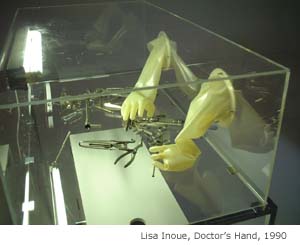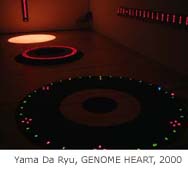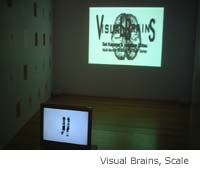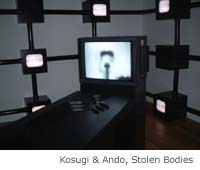
Not since Leonardo secretly dissected cadavers in renaissance Italy
has art paid as much attention to medicine as, it has in the last few
years. Perhaps this is a reflection of the cultural losses dues to AIDS
or the unraveling of human genes and the pictorialization of life through
computer imaging. Curator Kamikanda Kei at the ICC museum has explored
the area and put together a fascinating collection of art that connects
with medicine. Eight artists from Japan and around the world are included
in the exhibition 'Medicine as metaphor -- Art and Medicine'.
Artist Yama Da Ryu's installation uses the alphabet symbols from the DNA
model to represent all of life in just 5 letters; A, T, G, C, and U. These
letters -- the building blocks of life -- wizz around his installation
on mini red and yellow LED screens. Yama Da arranges the LED's in circles.
These flashing and dizzying displays of our genetic modules are mounted
on beds of beans. The beans are 'seeds of life' but are also the center
of controversial agricultural gene modification.
The visual arts rely on complex connections between eyes and brains. Understanding
those mechanisms is the business of Science and medicine. Accordingly
it is little wonder that 75% of the works in this exhibition feature these
organs. Visual Brains is the title of a the collaborative duo of Sei Kazama
and Hatsune Ohtsu. Both also work as television producers. Their 'self
portrait ' documentary video piece 'Scale' records the tests and measurements
that modern society has reduced childbirth to. Surrounding the video screen
are photographs of XY chromosomes from DNA tests.
Australian artist Justine Cooper has used MIR scans to create self-portraits
of her. 'Trapp self portrait 1998 uses MIR scans of her head. These are
captured on glass plate and arranged in order to create a picture of her
head that becomes visible when viewed from an oblique angle. By bobbing
about the viewer can reconstruct the head of the artist. Rapt also created
using MIR scans to create an animated video which takes the viewer through
a roller coaster journey through her anatomy until climactically reaching
her brain.
Mihoko Kosugi and Yasuhiko Ando's 1991 installation 'stolen bodies' is
given new life in a recreation for this exhibition. The piece, which includes
multiple video monitors, examines issues associated with organ transplants.
Eyes, pumping hearts and other bit of the bodies appear across the various
screens. Ominously the center of the space is filled with a table like
lifesized indented outline of the human figure Ð the annonimous donor.
Parts of bodies shifting from monitor to monitor cast questions of ownership
and identity. It is a mesmerizing and alarming vision; questions of life
and death ripple with every movement.
'Doctor's hand' is a series of works begun in 1990 by Lisa Inoue. Her
latest in this series is on display in this exhibition. 'Doctor's Hand',
literally allows visitors to experience the use of the remote mechanical
hands used by doctor's and scientists in surgery and experiement to ensure
separationn and safety from patients. Inue is also a medical historian
and her research has focussed on the experiments and writings of 19th
century medical researcher Sydney Ringer. Another instalation in the exhibiotn
by Inue uses artificial lungs and monitoring technology to simulate ideas
proposed by Ringer.
Also in the exhibitonn are the body art fashions by works by Eri Matsui
and Shingo harada. These cloths use the internal life systems of the body,
such as the circulatorary system as the basiss for cloting desing. , the
photographs of Makiko Koie Looking like abstract paintings of daubs of
color are of the microscopic cells of our bodies. The large pieces are
composed of multiple sections of a mass of cells.
The installation 'Kitchen ver. 2.0 Canon', by Kaoru Motomiya, is a light
hearted and jolly work. THe bodies dietry system is the focus of this
work based in a pink kitchen and which inlcudes a video of an over abundance
of olive oil. This is a facinating exhition of art that examines the human
body utilizing a range of new medical and research technologies. It is
also art that incorporates new multi-media technologies --from electron
microscopic imagering to computer generated virtual worlds-- in its display.
Contemporary art of interest to all.



